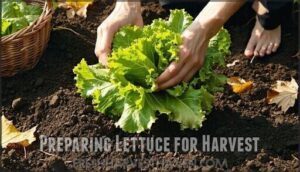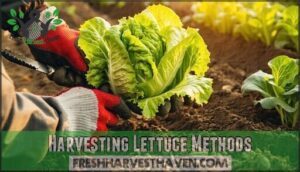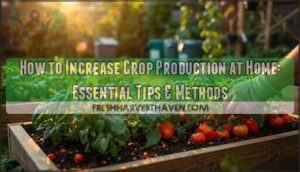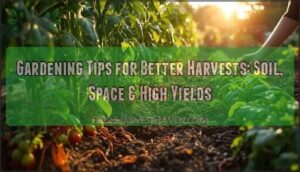This site is supported by our readers. We may earn a commission, at no cost to you, if you purchase through links.

Cool temperatures in the 50-70°F range transform bitter leaves into sweet, crisp perfection while slowing bolt formation.
You’ll get weeks more harvest time compared to spring plantings.
Start seeds 10-12 weeks before first frost, then watch as light frosts actually improve flavor rather than damage plants.
Use the cut-and-come-again method for continuous harvests, snipping outer leaves while centers keep producing.
Row covers extend your season well into winter in most regions.
The secret lies in timing your plantings with temperature drops rather than fighting summer heat, allowing for a longer and more successful harvest.
Table Of Contents
- Key Takeaways
- Fall Lettuce Harvest Time
- Preparing Lettuce for Harvest
- Harvesting Lettuce Methods
- Protecting Lettuce From Frost
- Post-Harvest Lettuce Handling
- Frequently Asked Questions (FAQs)
- When to start lettuce for fall harvest?
- Can you wait too long to harvest lettuce?
- When to harvest lettuce in fall?
- How do I know when my lettuce is ready to pick?
- How do you pick lettuce so it keeps growing?
- How do you harvest winter lettuce?
- How late can you harvest lettuce?
- How do you know when leaf lettuce is ready to harvest?
- How to store harvested lettuce long-term?
- Can lettuce regrow after harvesting?
- Conclusion
Key Takeaways
- Plant your lettuce 10-12 weeks before the first frost to take advantage of cool 50-70°F temperatures that create sweeter, less bitter leaves while preventing early bolting.
- Use the cut-and-come-again method by harvesting outer leaves while leaving the center intact – you’ll get weeks of continuous harvests instead of a one-time crop.
- Protect your plants with row covers to extend your harvest season well into winter, as light frosts actually improve flavor rather than damage cold-hardy lettuce varieties.
- Time your harvest during cool morning hours and store properly at 32-36°F with high humidity to maintain that crisp texture and prevent wilting for up to two weeks.
Fall Lettuce Harvest Time
Fall lettuce harvest timing depends on variety maturity dates and local frost predictions.
You’ll get the best results by monitoring leaf development and checking weather forecasts to harvest before hard freezes damage your crop.
Determining Optimal Harvest Date
Determining your lettuce harvest time starts with recognizing lettuce maturity signs like firm heads and 5-6 inch leaf height.
Check ideal leaf size daily while monitoring weather forecast impact on growth rates. Cool fall temperatures extend maturity by 1-2 weeks beyond seed packet estimates.
Examine soil moisture levels and watch for pest/disease influence that might affect quality. Harvest before bolting occurs for best results.
Using a sharp knife is ideal to harvest lettuce heads for best results and to ensure a clean cut, considering the growth rates.
Factors Affecting Lettuce Maturity
Several key factors shape your lettuce fall harvest timing.
Success depends on timing your harvest just right – variety, weather, and plant signals all matter.
Variety selection matters most – loose-leaf types mature in 45-55 days while crisphead needs 70-85 days.
Sunlight exposure decreases 40-50% in fall, slowing growth substantially.
Soil temperature below 50°F delays maturity, while water stress extends harvest by several days.
Nutrient availability, especially nitrogen, directly impacts lettuce fall growth rates and harvesting lettuce success.
Using row covers can offer valuable frost protection to ensure a successful fall harvest.
Weather Conditions and Harvest
Weather plays a big role in your fall lettuce harvest timing.
Mother Nature calls the shots when it comes to your lettuce harvest timeline.
Temperature Effects and Sunlight Exposure directly impact growth rates, while Rainfall Impact can delay harvesting fall lettuce.
You’ll want to monitor Humidity Levels and protect against Wind Damage.
Smart timing means watching the forecast like a hawk.
- Temperature drops below 50°F slow growth substantially, extending harvest windows by 7-10 days
- Morning frost requires immediate harvest – lettuce cell walls rupture and create mushy leaves
- Excessive rainfall creates waterlogged soil conditions that promote root rot and bitter flavors
- High winds can physically damage tender outer leaves and accelerate moisture loss
Preparing Lettuce for Harvest
Proper preparation sets the foundation for a successful lettuce harvest, transforming your garden soil into a nutrient-rich environment that produces crisp, flavorful leaves.
You’ll need to focus on three key areas: enriching your soil with the right fertilizers, choosing compatible companion plants, and establishing effective mulching and watering systems.
Soil Preparation and Fertilization
Before starting your fall lettuce harvest, you’ll want to test your soil’s pH levels and nutrient content.
Most lettuce varieties thrive in slightly acidic to neutral soil (6.0-7.0 pH).
Add compost or well-aged manure to boost organic matter and improve nutrient cycling.
Choose natural fertilizers like fish emulsion for steady nitrogen release during your lettuce fall care routine.
Accurate soil analysis requires using soil test kits to determine the ideal fertilizer application for optimal results.
Companion Planting for Lettuce
Smart plant pairing transforms your fall garden lettuce into thriving companions.
Carrots, radishes, and onions make excellent lettuce companions, improving soil health through natural crop rotation. These coolseason crops share similar growing requirements while deterring pests.
Strategic garden planning pairs lettuce with herbs like chives and dill for natural protection. Your lettuce fall care benefits from thoughtful companion planting arrangements, which can include coolseason crops.
Mulching and Irrigation Techniques
Your fall lettuce crop thrives with proper soil moisture management through strategic mulching and drip irrigation systems.
Apply organic mulch types like straw or shredded leaves around plants to retain water conservation while regulating temperature.
Drip irrigation delivers consistent crop hydration directly to roots, preventing leaf diseases common during lettuce fall season.
Monitor soil moisture levels weekly—lettuce needs steady hydration but hates soggy conditions that’ll turn your gardening efforts into mush.
Effective use of drip irrigation systems can substantially improve crop yields and overall garden health.
Harvesting Lettuce Methods
You have three main options when harvesting lettuce: cutting outer leaves for continuous harvests, harvesting entire heads at maturity, or picking tender baby leaves early in the season.
Each method offers different benefits depending on your garden goals and the lettuce varieties you’re growing, which can be influenced by choosing the right method for harvesting.
Cut-and-Come-Again Harvesting
Cut-and-come-again harvesting maximizes your lettuce fall season yield through strategic leaf removal. This method boosts regrowth speed and maintains exceptional leaf quality throughout the harvest season.
Here’s your approach for ideal plant vigor:
- Harvest Frequency: Cut outer leaves every 7-14 days, leaving 1-2 inches above the crown
- Leafy Greens Selection: Focus on looseleaf and romaine varieties for best results
- Successive Planting: Stagger new plantings while harvesting established plants
This technique delivers 30-50% more lettuce harvest tips than single-cut methods.
Whole Head Harvesting Technique
While cut-and-come-again works great for ongoing harvests, whole head harvesting gives you complete lettuce heads at peak maturity.
Wait until heads reach full size but before outer leaves start yellowing. Use clean, sharp tools with proper tool sterilization to cut at the cutting point near soil level, preserving the root system.
| Head Size | Cutting Point | Tool Sterilization |
|---|---|---|
| 6-8 inches diameter | 1 inch above soil | Rubbing alcohol wipe |
| Firm, dense center | Clean cut through stem | Bleach solution dip |
| Outer leaves crisp | Avoid root damage | Between-plant cleaning |
Baby Leaf Harvesting Method
Baby leaf lettuce offers continuous harvest potential throughout fall planting seasons.
When leaves reach ideal leaf size of 2-4 inches, use scissors to cut at proper cutting height—about one inch above soil level.
This harvesting frequency of every 7-10 days maximizes crop yield while ensuring post-cut care through gentle watering.
To maintain freshness, remember to cool lettuce immediately after harvesting.
Maintain appropriate seedling density spacing for vigorous regrowth during harvest festivals season, ensuring proper care.
Protecting Lettuce From Frost
As fall temperatures drop, you’ll need to shield your lettuce from frost damage that can turn crisp leaves into wilted disappointment overnight.
Smart frost protection techniques let you extend your harvest season by several weeks, giving you fresh greens well into winter.
Row Covers and Cold Frame Use
Someone clever once said, "Good fences make good neighbors" – the same goes for protecting your fall lettuce varieties.
Row covers and cold frames create essential barriers against frost while extending your growing season. Cold-tolerant plants such as arugula and spinach thrive under these conditions.
Cover Materials for fall lettuce cultivation:
- Heavyweight row covers provide 4-8°F frost protection
- Cold frame design with clear plastic retains more heat than fabric
- Spunbonded polypropylene allows 75-95% light transmission
These protective systems excel at pest exclusion while maintaining proper ventilation needs for healthy growth.
Natural Pest Control and Fertilizers
During fall lettuce gardening, you’ll want to boost your plants’ defenses naturally.
Apply compost tea weekly for natural fertilizers that strengthen soil health without harsh chemicals.
Marigolds and nasturtiums make excellent companion planting choices, deterring aphids and other pests.
These organic pest control methods work better than sprays in cool weather.
DIY solutions like crushed eggshells around plants prevent slugs effectively.
You can also use diatomaceous earth powder for crawling insects, which is a great example of natural fertilizers and organic pest control that can be used to strengthen soil health and deter pests, making it a good choice for fall lettuce gardening.
Microclimate Creation for Lettuce
Creating a protective microclimate transforms your fall lettuce gardening success.
Strategic windbreaks and row covers provide wind protection while maintaining proper humidity control. Position thermal mass like stone walls nearby for temperature regulation during chilly nights.
Modify soil with organic matter to retain warmth. Smart sunlight management using shade cloth prevents bolt-inducing heat spikes, ensuring your lettuce care fall efforts yield crisp, perfect heads, through strategic windbreaks and temperature regulation.
Post-Harvest Lettuce Handling
Once you’ve harvested your fall lettuce, proper handling becomes essential for maintaining quality and extending shelf life.
You’ll need to clean, sort, and store your harvest correctly to prevent wilting and preserve that crisp texture you worked so hard to achieve.
Cleaning and Sorting Lettuce
Once you’ve protected your fall lettuce planting from harsh weather, proper washing methods become your next priority.
Rinse harvested leaves in cold water to remove soil and debris. Use a salad spinner for drying lettuce effectively.
Apply quality control by sorting criteria like size, color, and texture. Remove damaged leaves to minimize contamination risks during growing lettuce fall seasons, ensuring a successful fall lettuce planting.
Proper Storage and Shelf Life
Once you’ve cleaned your fresh produce, proper storage becomes your next priority.
Store lettuce at 32-36°F with ideal humidity levels of 95-98%.
Use perforated storage containers to prevent condensation while allowing air circulation. Temperature control is critical – fluctuations above 41°F accelerate spoilage.
Avoid washing effects by storing unwashed heads, which maintain quality longer. Different varieties offer varying shelf life potential, with romaine lasting 14-21 days under ideal conditions while baby lettuce requires consumption within one week, due to its shorter shelf life and the need for proper storage.
Preventing Wilting and Browning
Hydration methods keep your harvest crisp longer.
Store lettuce at 32-36°F with high humidity to prevent wilting.
Antioxidant sprays containing ascorbic acid slow browning naturally.
Control ethylene exposure by separating lettuce from ripening fruits.
Blanching techniques work for preserving excess fall lettuce seeds harvests.
Proper storage temperature and garden maintenance after planting lettuce fall guarantees quality through lettuce fall weather conditions.
To maximize yields, consider the cut and come again method for harvesting, using hydration methods, antioxidant sprays, and blanching techniques to ensure a crisp harvest.
Frequently Asked Questions (FAQs)
When to start lettuce for fall harvest?
You’ll need to plant lettuce seeds 10-12 weeks before your first expected fall frost.
Count backwards from that date to determine your sowing time.
Cool-season varieties thrive in fall’s dropping temperatures.
Can you wait too long to harvest lettuce?
Crisp lettuce leaves can turn bitter and bolt when you delay harvest too long.
You’ll notice the leaves becoming tough, developing a milky sap, and stretching upward as they prepare to flower—ruining their sweet, tender texture, which can be described as turning bitter.
When to harvest lettuce in fall?
Fall lettuce thrives in cool temperatures between 45-65°F.
You’ll harvest most varieties 60-80 days after seeding, typically before hard frost hits.
Check leaves regularly—they’re ready when crisp and full-sized but before bolting occurs.
How do I know when my lettuce is ready to pick?
Like a perfectly ripe fruit calling from the tree, you’ll know lettuce is ready when outer leaves feel firm and crisp to your touch.
Check for full-sized heads with tightly packed leaves and vibrant color—that’s your green light for harvest time.
How do you pick lettuce so it keeps growing?
Cut outer leaves with clean scissors or knife, leaving the center growing point intact. You’ll get continuous harvests for weeks as new leaves regenerate from the heart.
How do you harvest winter lettuce?
When winter’s icy grip tightens, you’ll cut outer leaves first, leaving the crown intact.
Harvest during warmer midday hours when leaves aren’t frozen.
Use sharp scissors to snip individual leaves at the base, allowing continuous regrowth throughout winter’s cold months.
How late can you harvest lettuce?
You can harvest lettuce well into December or even January, depending on your variety and protection methods.
Cold-hardy types like buttercrunch and romaine tolerate frost better than delicate greens.
With row covers or cold frames, you’ll extend your harvest window by several weeks, giving you fresh salads when neighbors are buying expensive store lettuce, using methods like cold frames.
How do you know when leaf lettuce is ready to harvest?
Picture leaves as nature’s green flags signaling readiness—you’ll know leaf lettuce is ready when outer leaves reach 4-6 inches long with vibrant color and crisp texture.
Typically, this occurs 45-65 days after planting, at which point the leaves should have vibrant color and crisp texture.
How to store harvested lettuce long-term?
You’ll extend freshness by washing leaves gently, spinning dry thoroughly, then wrapping in damp paper towels before refrigerating in perforated bags for up to two weeks maximum.
Can lettuce regrow after harvesting?
Incredibly, lettuce can regrow after you’ve harvested it.
You’ll get best results using the "cut-and-come-again" method—snip outer leaves while keeping the growing center intact.
The plant’s meristem tissue regenerates new growth within days.
Conclusion
Like Demeter blessing her autumn fields, harvesting lettuce in fall rewards patient gardeners with nature’s sweetest gifts.
You’ve mastered the art of cool-season cultivation, transforming your garden into a crisp lettuce paradise.
Your timing with temperature drops, protective row covers, and cut-and-come-again methods guarantees continuous harvests through winter’s approach.
Remember to harvest in cool morning hours and store properly to maximize freshness.
Fall’s generous bounty proves that sometimes the best crops come when summer’s heat finally retreats, offering a crisp lettuce paradise.







